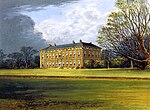Hessay railway station
1849 establishments in England1964 disestablishments in EnglandDisused railway stations in North YorkshireFormer North Eastern Railway (UK) stationsPages with no open date in Infobox station ... and 6 more
Railway stations in Great Britain closed in 1915Railway stations in Great Britain closed in 1958Railway stations in Great Britain opened in 1849Railway stations in Great Britain opened in 1922Use British English from June 2017Yorkshire and the Humber railway station stubs

Hessay railway station served the village of Hessay, North Yorkshire, England from 1849 to 1964 on the Harrogate line.
Excerpt from the Wikipedia article Hessay railway station (License: CC BY-SA 3.0, Authors, Images).Hessay railway station
New Road,
Geographical coordinates (GPS) Address Nearby Places Show on map
Geographical coordinates (GPS)
| Latitude | Longitude |
|---|---|
| N 53.9794 ° | E -1.2009 ° |
Address
New Road
New Road
YO26 8LE
England, United Kingdom
Open on Google Maps











